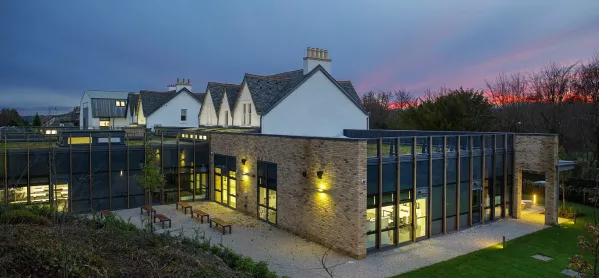- Home
- Can a school building improve results?
Can a school building improve results?

I recall sitting at the back of my maths classroom, a typical angst-ridden teenager, etching some tortured declaration of love into the chipped wooden desk. I remember swinging on my cracked plastic tub chair paying little heed to Mr Needson’s trigonometry demonstration on the grubby whiteboard.
The room is like all the others in the school - fit for purpose (just). It can house 30 or so desks. The décor is tired but passable. A couple of ceiling tiles have slipped out of place. A collection of posters displaying “motivational” quotes about the value of hard work cling to the walls with Blu Tack; there is evidence of long-gone posters, splodges in the plaster where the paint has been stripped away. Windows, stiff with age, are wedged open a crack, where possible. The room is stuffy and hot and I am struggling to think of anything other than dreamy Richard Patterson in the year above me.
New school building ‘has immeasurable effect’
A couple of decades on, I am depute rector of St Columba’s School, watching from the front row the impact that a well-designed, well-maintained teaching space has on the concentration, behaviour and learning of young people - and wondering why some headteachers and local education authorities of years gone by have failed to recognise this.
Quick read: Why the design of school buildings matters
‘Our crumbling schools’: Campaign highlights “grim” impact of dilapidated schools
Long read: The freedom - and pressure - of leading Scotland’s first brand-new secondary in 17 years
In the independent sector, the maintenance of school buildings - many of them listed - can be an anchor around the board of governors’ neck, a black hole into which money is sunk with few visible benefits to pupils. Committing to spending millions on the purchase and renovation of new buildings can be an even more daunting business: a tough sell to parents on whom a capital levy will inevitably have to be placed; a challenging negotiation with local residents and neighbours; a long and time-consuming planning process. For many schools, significant investment in buildings and classroom design is a risk that is simply not worth taking. For those who commit to making that vision a reality, however, the reward for pupils and teachers can be immeasurable.
It is two years since St Columba’s opened its state-of-the-art teaching facility, the Girdwood Building (pictured), named after the school’s last rector, David Girdwood. We have now had two years of teaching and learning in the 13 new classrooms, of tailored pastoral care in the guidance suite, of quiet reflective reading and study in the new library, and it is time to consider whether it has all been worth it.
The school long ago purchased two detached Victorian houses (one slightly worse for wear), and employed Page\Park Architects in Glasgow to design a new school building that would fit seamlessly into the campus and the beautiful stone-built village of Kilmacolm. Externally, the end result, completed by Burnett Bell architects, is exquisite. Inside, the overwhelming effect is one of space and light.
And the pupils’ verdict? Senior pupil Harry Kellock talked about his “improved focus”, and was not alone. Finlay Cooper said: “It is so spacious. I feel alert.” Almost every pupil who was asked commented on the space and light and the impact this has had on their concentration. Hannah Findlater explained how the building affected the relationship between staff and pupils, with “a renewed sense of respect, not just for our surroundings but for each other”.
In terms of academic achievement, it is difficult to establish a causal link between exam results and our new building; perhaps the fact that English and languages were two of the highest-achieving faculties last year is just coincidence. Or, perhaps, the quality of the teaching and learning experience has been directly influenced by the quality of this extraordinary building design.
Antonia Berry is depute rector at St Columba’s School, a coeducational independent day school for pupils aged 3-18 in Kilmacolm, on the outskirts of Glasgow
Keep reading for just £1 per month
You've reached your limit of free articles this month. Subscribe for £1 per month for three months and get:
- Unlimited access to all Tes magazine content
- Exclusive subscriber-only stories
- Award-winning email newsletters

